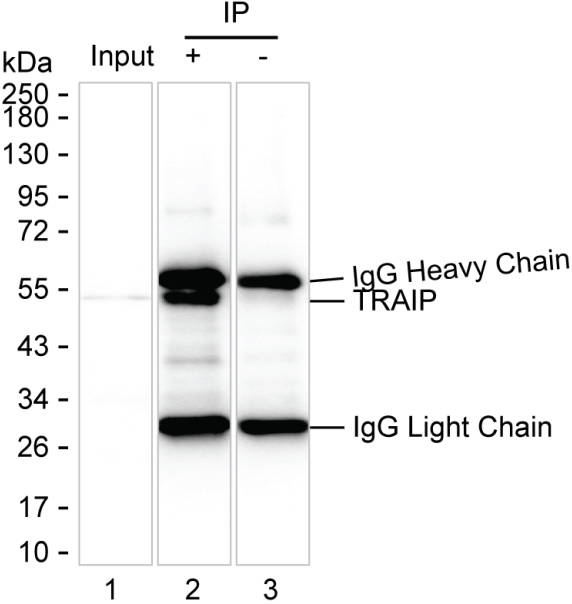
| WB | 咨询技术 | Human,Mouse,Rat |
| IF | 1/100-1/200 | Human,Mouse,Rat |
| IHC | 咨询技术 | Human,Mouse,Rat |
| ICC | 技术咨询 | Human,Mouse,Rat |
| FCM | 咨询技术 | Human,Mouse,Rat |
| Elisa | 咨询技术 | Human,Mouse,Rat |
| Host/Isotype | Mouse IgG2a |
| Antibody Type | Primary antibody |
| Storage | Store at 4°C short term. Aliquot and store at -20°C long term. Avoid freeze/thaw cycles. |
| Species Reactivity | Human, Mouse |
| Immunogen | Purified recombinant fragment of human TRAIP |
| Formulation | Purified antibody in PBS with 0.05% sodium azide |
+ +
1. **"TRAIP regulates replication stress response through interaction with replication protein A"**
- 作者:Marineau, J.J. 等
- 摘要:研究揭示了TRAIP通过与复制蛋白A(RPA)相互作用,在DNA复制应激中协调修复机制,维持基因组稳定性。
2. **"TRAIP promotes cell proliferation and tumorigenesis through ubiquitination-dependent signaling pathways"**
- 作者:Hoffman, R.M. 等
- 摘要:探讨TRAIP通过泛素化修饰调控细胞周期蛋白的稳定性,促进癌细胞增殖,并与多种癌症患者不良预后相关。
3. **"Structural insights into TRAIP’s role in DNA damage bypass and replication fork restart"**
- 作者:Wu, R.A. 等
- 摘要:通过冷冻电镜解析TRAIP蛋白结构,阐明其介导停滞复制叉重启的分子机制,及其与泛素化酶的协同作用。
4. **"TRAIP mutations link neurodevelopmental disorders to impaired DNA damage response"**
- 作者:Fan, Y. 等
- 摘要:发现TRAIP基因突变导致神经发育异常,其机制与DNA损伤修复缺陷及神经元凋亡增加相关,为疾病治疗提供新靶点。
TRAIP (TRAF-interacting protein) is a conserved eukaryotic protein involved in DNA repair, replication stress response, and cell cycle regulation. Initially identified through its interaction with TNF receptor-associated factors (TRAFs), TRAIP functions as an E3 ubiquitin ligase with critical roles in maintaining genome stability. Structurally, it contains an N-terminal RING domain (mediating ubiquitination), a central coiled-coil region, and a C-terminal domain that facilitates interactions with replication/repair machinery like the CRL2-TRAIP complex.
Research has linked TRAIP to multiple cellular processes: resolving replication fork conflicts during mitosis, promoting restart of stalled replication forks, and participating in nucleolar stress responses. Its dysfunction is associated with severe developmental disorders, including congenital skin poikiloderma (caused by TRAIP mutations) and microcephaly in model organisms. TRAIP also shows relevance in cancer biology, with altered expression observed in various tumors, potentially influencing chemotherapy sensitivity.
TRAIP-specific antibodies are vital tools for studying these mechanisms. They enable detection of TRAIP expression/localization via techniques like Western blot, immunofluorescence, or immunohistochemistry. Antibodies targeting distinct domains help dissect TRAIP's molecular interactions, post-translational modifications, and functional dynamics during DNA damage responses. Knockdown/knockout models combined with antibody-based analyses have revealed TRAIP's essential role in early embryogenesis and cell viability. Ongoing research explores TRAIP as a potential therapeutic target, particularly in cancers with replication stress vulnerabilities.
×